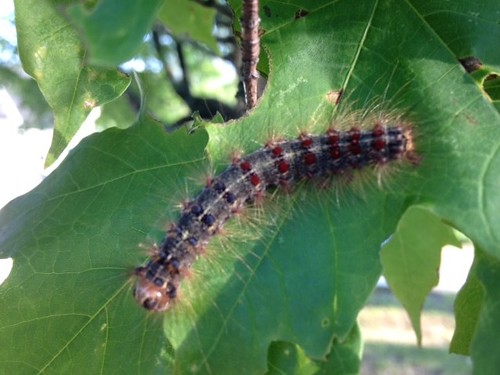
While being outside in Massachusetts this June, I first noticed it. A lot of leaves were falling from the trees, only these were chewed leaf parts, not whole leaves.
Similar to the children's book, The Very Hungry Caterpillar written by Eric Carle, some leaves didn’t just have chew marks but actual holes going straight through them. Unlike the children’s book, this damage isn’t being caused by a friendly caterpillar who turns into a butterfly. Instead it’s the result of ravenous gypsy moth caterpillars feeding…and feeding. It’s so bad that in some areas, on walkways and roadways, it looks like fall. Brown, dried up leaves are a contrast to summer’s lush greenery.
What comes along with all the feeding and falling leaf parts? Caterpillar feces, everywhere. It too covers walkways and roadways. And you don’t have to listen hard to hear the feeding, or the leaves and feces dropping. The chewing is constant and so are the droppings. It almost sounds like rain falling, continuously. I regret that I did not take a picture of a car covered with caterpillar feces that I saw at the grocery store this weekend, which looked like it had peppercorns stuck all over it. Don’t park under a tree, or like everything else, your car will be covered.
Gypsy moth is not everywhere in the United States. It’s primarily in the northeast to mid-west, and it’s Federal and State agriculture officials’ goal to not let it spread further. You can do your part to help by finding out if you are in an area that already has gypsy moth, and if you’re not, report any gypsy moth egg masses or caterpillars on trees to Federal or State agriculture officials. Also, the USDA’s Animal and Plant Health Inspection Service (APHIS) is asking folks to check for gypsy moth before you move to a new area by inspecting your outdoor household articles (lawn furniture, yard equipment, outdoor toys, etc.) for gypsy moth egg masses and remove them. It's not just the right thing to do—it's also the law. And now it’s easier than ever because APHIS just made its gypsy moth inspection checklist a fillable PDF (page 2 of our gypsy moth factsheet) that can be digitally signed, making it acceptable in all situations where the form is required.
The gypsy moth caterpillars here in Massachusetts are ruining thousands of trees, changing the way the landscape looks. The crabapple tree I planted two years ago didn’t bloom this year, and it may not survive these gypsy moth caterpillar attacks. Please help prevent this insect from moving to other areas by visiting www.HungryPests.com to learn more about gypsy moth and other invasive pests we don’t want in the United States.

